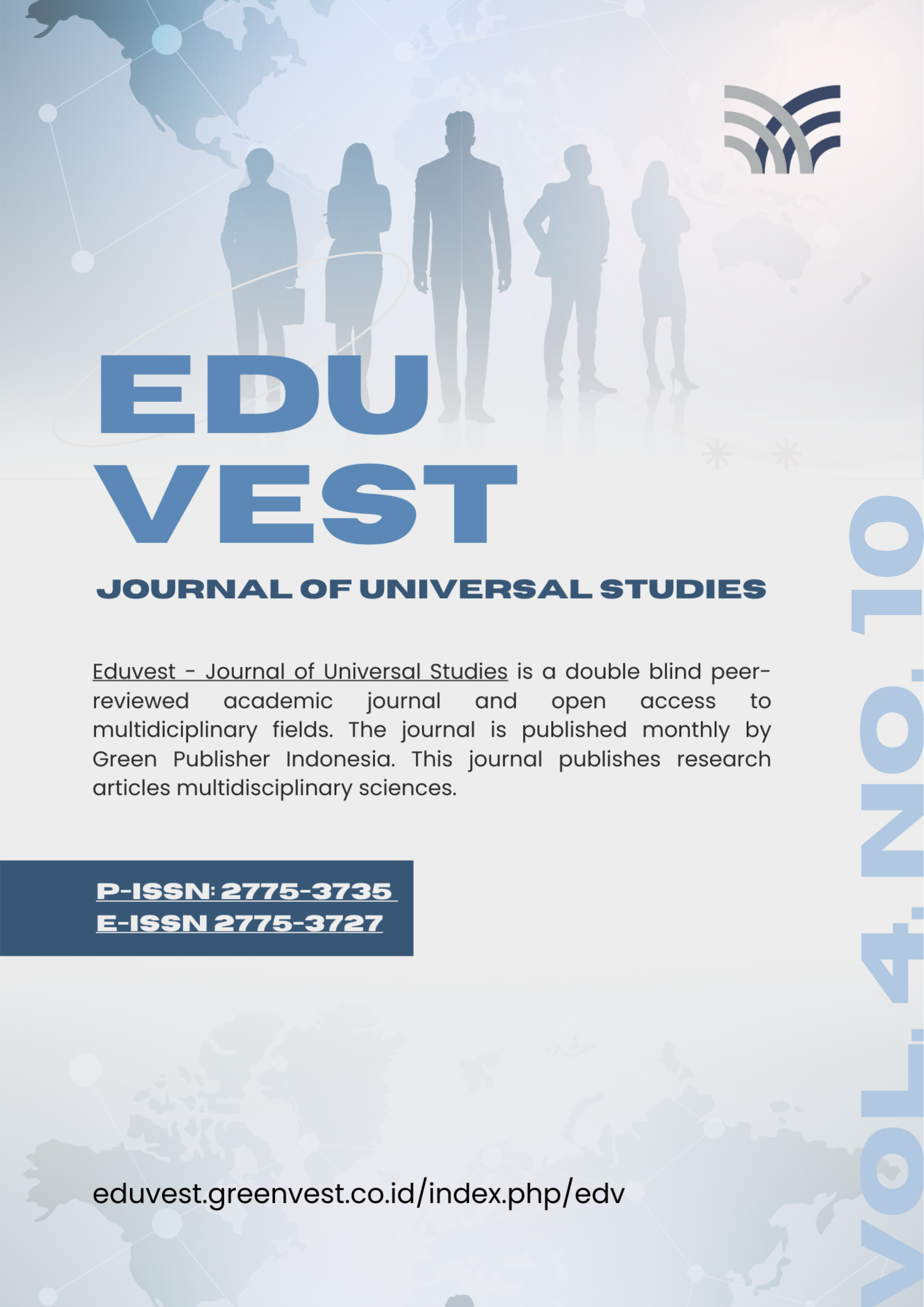Intellectual Property Commercialization Policy to Expand Financing Options for Indonesian Creative Economy Businesses
DOI:
https://doi.org/10.59188/eduvest.v4i10.43131Keywords:
Creative Economy Business, Intellectual Property, Financing Scheme, SWOT Matrix, Policy Analysis, Implementation StrategyAbstract
This study aims to develop alternate strategies for completing the creative economy Intellectual Property collateral financing policy so that it may be implemented in Indonesia. The methods used descriptive qualitative research with SWOT analysis to analyze the implementation of Intellectual Property-based financing schemes' supporting and inhibiting factors. The preparation of alternative strategies based on the SWOT matrix produces nine strategies. The nine alternative strategies produced were evaluated and tested using four practical policy analysis criteria: Effectiveness, Efficiency, Legality, and Administrative Robustness. Three primary recommendations emerged from testing alternative approaches: first, a plan to fortify industry regulations related to financial services, which will serve as a model for financial institutions implementing credit provisions based on Intellectual Property collateral and expediting the realization of financing products backed by Intellectual Property Rights. Second, a plan to standard Intellectual Property valuation formula or economic value of Intellectual Property and establish an ecosystem for the Intellectual Property market to promote more consistent Intellectual Property valuations and third, managing credit risk through joint ventures with insurance companies, the debtor will pay the insurance costs that allow the Bank or Financial Institutions to transfer risks to third parties if the Intellectual Property value declines.
References
Bambang Prayogo. (2018). Journal of Public Administration Studies Corporate Values. 3(1), 1–4.
Bardach, E., & Patashnik, E. M. (2023). A practical guide for policy analysis: The eightfold path to more effective problem solving. CQ press.
Bilan, Y., Vasilyeva, T., Kryklii, O., & Shilimbetova, G. (2019). THE CREATIVE INDUSTRY AS A FACTOR IN THE DEVELOPMENT OF THE ECONOMY: DISSEMINATION OF EUROPEAN EXPERIENCE IN THE COUNTRIES WITH ECONOMIES IN TRANSITION. Creativity Studies, 12(1), 75–101. https://doi.org/10.3846/cs.2019.7453
Boğa, S., & Topcu, M. (2020). Creative Economy: A Literature Review on Relational Dimensions, Challanges, and Policy Implications. ECONOMICS, 8(2), 149–169. https://doi.org/10.2478/eoik-2020-0014
Caves, R. E. (2003). Contracts Between Art and Commerce. Journal of Economic Perspectives, 17(2), 73–83. https://doi.org/10.1257/089533003765888430
Chu, S., & Gao, C. (2019). Intellectual property protection and creative enterprises’ investment efficiency: alleviating financing constraints or inhibiting agency problem? Asia-Pacific Journal of Accounting & Economics, 26(6), 747–766. https://doi.org/10.1080/16081625.2019.1566010
Chung, C., Yang, L., & Cauldwell-French, E. (2018). Growing the UK’s creative industries: what creative enterprises need to thrive and grow.
David, F. R., & David, F. R. (2016). Manajemen strategik: Suatu pendekatan keunggulan bersaing. Jakarta: Salemba Empat.
Fadli, M. A., Muhammad Pravest Hamidi, Farhan Azzahra Edwin, & Rayyan Gustio Kevin Aritonang. (2023). Let’s Play Content as a Fiduciary Collateral under Indonesian Law: Potential Challenges. Yuridika, 38(3), 481–498. https://doi.org/10.20473/ydk.v38i3.44756
Fraser, S., & Lomax, S. (2011). Access to finance for creative industry businesses. Department for Business and Innovation & Skills (BIS) and Media and Sport (Dcms) and Department for Culture (Final Report May 2011).
García Lorente, J. (2016). The creative economy: The new El Dorado that Europe and Latin America want to lead. IE University.
Khoo, O. (2010). Intellectual Property and the Creative Industries in Asia (China and Singapore). Asia Pacific Law Review, 18(1), 151–170. https://doi.org/10.1080/10192557.2010.11788230
Mahmudah, F., Alexandri, M. B., & Sugandi, Y. S. (2024). Scenario Planning of IP-Based Financing Scheme Implementation Study on the Animation Creative Industry. Eduvest-Journal of Universal Studies, 4(7), 6075–6093.
Mayana, R. F., Santika, T., & Cintana, Z. (2022). Skema Pembiayaan Berbasis Kekayaan Intelektual: Peluang, Tantangan dan Solusi Potensial Terkait Implementasinya (Intellectual Property–Based Financing Scheme: Opportunity, Challenge and Potential Solutions). Das Soll. J. Kaji. Kontemporer Huk. Dan Masy, 1, 1.
Nikitenko, S. M., & Mesyats, M. A. (2019). Intellectual property rights as the resource for innovative economy development. IOP Conference Series: Earth and Environmental Science, 377, 012012. https://doi.org/10.1088/1755-1315/377/1/012012
Nikitenko, S. M., Mesyats, M. A., & Pakhomova, E. O. (2017). Intellectual property as instrument for implementation of innovative technologies. Proceedings of the International Conference on Trends of Technologies and Innovations in Economic and Social Studies 2017. https://doi.org/10.2991/ttiess-17.2017.78
Nugroho, G. K. (2021). Applying Bardach and Patashnik’s Policy Concept to Educational Leadership Development Effort in the Developing World. Studia Philosophica et Theologica, 21(1), 114–127.
Oreski, D. (2012). Strategy development by using SWOT-AHP. TEM Journal, 1(4), 283–291.
Pariwisata, K. (2021). Statistik Industri Pariwisata dan Ekonomi Kreatif 2020. Pusat Data Dan Sistem Informasi Kementerian Pariwisata Dan Ekonomi Kreatif/Badan Pariwisata Dan Ekonomi Kreatif.
Pribadi, K. S., & Chan, T.-K. (2022). Indonesia and National Development Planning. In Construction in Indonesia (pp. 1–18). Routledge.
Robby, M. A., Mulyati, E., & Harrieti, N. (2022). Optimalisasi Pembiayaan Perusahaan Modal Ventura Terhadap Pelaku Usaha Kecil Berbasis Ekonomi Kreatif Yang Berkeadilan. Pagaruyuang Law Journal, 6(1), 26–51. https://doi.org/10.31869/plj.v0i0.3821
Rosyadi, S., Sabiq, A., Ahmad, A. A., & Yamin, M. (2021). The Cross-Sector Collaboration for Development Policy of Rural Creative Economy: The Case of Bengkoang Creative Hub. Journal of Governance and Public Policy, 8(1), 10–21.
Schultz, M. P. (2004). An International Experience. NASNewsletter, 19(1), 13–13. https://doi.org/10.1177/104747570401900103
Tanwir S. H., M. H. , Dr. R. F. M., & S. H., M. Hum. , M. Kn. , D. H. (2019). ALTERNATIVE RESOLUTION OF INTELLECTUAL PROPERTY DISPUTES AS PART OF INVESTMENT IN THE CREATIVE INDUSTRY SECTOR UNDER INDONESIAN LAW. Humanities & Social Sciences Reviews, 7(5), 93–97. https://doi.org/10.18510/hssr.2019.7512
Published
How to Cite
Issue
Section
License
Copyright (c) 2024 Fitria Mahmudah, Mohammad Benny Alexandri, Yogi Suprayogi Sugandi

This work is licensed under a Creative Commons Attribution-ShareAlike 4.0 International License.











